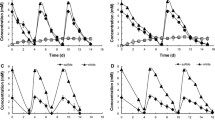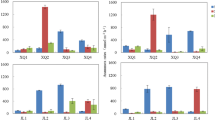Abstract
Anaerobic ammonium oxidation (anammox) is believed to be an important sink for fixed inorganic nitrogen in terrestrial and aquatic ecosystems, and many studies have reported that macroscale oxic–anoxic interfaces, such as riparian zones, were hotspots of anammox reaction. However, no research has linked microscale interfaces with the anammox process in natural environments. This study provides evidence for the presence of anammox bacteria and potential anammox activity on the suspended sediment (SPS) in the oxic water of the Yellow River. The anammox bacteria in the overlying water were mainly attached to SPS. The abundance of anammox bacteria in the overlying water was positively correlated with SPS concentration (R 2 = 0.97, P < 0.01), with abundance ranging from 9.5 × 102 to 1.5 × 104 hydrazine synthase gene copies per g of SPS. Phylogenic analysis of anammox bacteria revealed that the SPS phase was dominated by Candidatus Brocadia. Candidatus Scalindua genera was detected in this study with a conductivity of 1100 μS cm−1. Moreover, \(^{15} {\text{NH}}_{4}^{ + }\)-amended anaerobic incubation of the overlying water showed that the average potential anammox activity was 0.076 nmol-N L−1 day−1. The 15N labeling simulation experiments demonstrated the occurrence of anammox in the oxic water of the Yellow River. This study suggests that the anammox process at the SPS–water interface might be a non-negligible pathway for the loss of fixed nitrogen in natural freshwaters, but this remains to be determined in further studies.






Similar content being viewed by others
References
Alldredge AL, Cohen Y (1987) Can microscale chemical patches persist in the sea? Microelectrode study of marine snow, fecal pellets. Science 235:689–691
Bianchi TS, Mitra S, McKee BA (2002) Sources of terrestrially-derived organic carbon in lower Mississippi River and Louisiana shelf sediments: implications for differential sedimentation and transport at the coastal margin. Mar Chem 77:211–223
Dale OR, Tobias CR, Song B (2009) Biogeographical distribution of diverse anaerobic ammonium oxidizing (anammox) bacteria in Cape Fear River estuary. Environ Microbiol 11:1194–1207
Dalsgaard T, Canfield DE, Petersen J, Thamdrup B, Acuna-Gonzalez J (2003) N2 production by the anammox reaction in the anoxic water column of Golfo Dulce, Costa Rica. Nature 422:606–608
Dalsgaard T, Thamdrup B, Canfield DE (2005) Anaerobic ammonium oxidation (anammox) in the marine environment. Res Microbiol 156:457–464
Devol AH (2003) Nitrogen cycle - Solution to a marine mystery. Nature 422(6932):575–576
Droppo I, Ongley E (1994) Flocculation of suspended sediment in rivers of southeastern Canada. Water Res 28:1799–1809
Egli K, Fanger U, Alvarez PJ, Siegrist H, van der Meer JR, Zehnder AJ (2001) Enrichment and characterization of an anammox bacterium from a rotating biological contactor treating ammonium-rich leachate. Arch Microbiol 175:198–207
Falkowski PG, Fenchel T, Delong EF (2008) The microbial engines that drive Earth’s biogeochemical cycles. Science 320:1034–1039
Fofonoff NP, Millard RC (1983) Algorithms for computation of fundamental properties of seawater. UNESCO, Paris
Hamersley MR, Woebken D, Boehrer B, Schultze M, Lavik G, Kuypers MM (2009) Water column anammox and denitrification in a temperate permanently stratified lake (Lake Rassnitzer, Germany). Syst Appl Microbiol 32:571–582
Harhangi HR, Le Roy M, van Alen T, Hu BL, Groen J, Kartal B, Tringe SG, Quan ZX, Jetten MSM, den Camp HJMO (2012) Hydrazine synthase, a unique phylomarker with which to study the presence and biodiversity of anammox bacteria. Appl Environ Microbiol 78(3):752–758
Holtappels M, Lavik G, Jensen MM, Kuypers MM (2011) 15N-labeling experiments to dissect the contributions of heterotrophic denitrification and anammox to nitrogen removal in the OMZ waters of the ocean. Method Enzymol 486:223–251
Hou LJ, Zheng YL, Liu M, Gong J, Zhang XL, Yin GY, You L (2013) Anaerobic ammonium oxidation (anammox) bacterial diversity, abundance, and activity in marsh sediments of the Yangtze Estuary. J Geophys Res 118(3):1237–1246
Hu BL, Shen LD, Zheng P, Hu AH, Chen TT, Cai C, Liu S, Lou LP (2012) Distribution and diversity of anaerobic ammonium-oxidizing bacteria in the sediments of the Qiantang River. Environ Microbiol Rep 4:540–547
Jia Z, Liu T, Xia X, Xia N (2016) Effect of particle size and composition of suspended sediment on denitrification in river water. Sci Total Environ 541:934–940
Jiyu C, Cangzi L, Chongle Z, Walker HJ (1990) Geomorphological development and sedimentation in Qiantang Estuary and Hangzhou Bay. J Coastal Res 6(3):559–572
Kalvelage T, Jensen MM, Contreras S, Revsbech NP, Lam P, Gunter M, LaRoche J, Lavik G, Kuypers MMM (2011) Oxygen sensitivity of anammox and coupled N-cycle processes in oxygen minimum zones. PLoS ONE 6(12):12
Kartal B, Maalcke WJ, de Almeida NM et al (2011) Molecular mechanism of anaerobic ammonium oxidation. Nature 479:127–130
Kartal B, de Almeida NM, Maalcke WJ, den Camp HJMO, Jetten MSM, Keltjens JT (2013) How to make a living from anaerobic ammonium oxidation. FEMS Microbiol Rev 37:428–461. doi:10.1111/1574-6976.12014
Kuenen JG (2008) Anammox bacteria: from discovery to application. Nat Rev Microbiol 6:320–326
Kuypers MMM, Lavik G, Woebken D, Schmid M, Fuchs BM, Amann R, Jorgensen BB, Jetten MSM (2005) Massive nitrogen loss from the Benguela upwelling system through anaerobic ammonium oxidation. Proc Natl Acad Sci USA 102(18):6478–6483
Lam P, Lavik G, Jensen MM et al (2009) Revising the nitrogen cycle in the Peruvian oxygen minimum zone. Proc Natl Acad Sci USA 106:4752–4757
Li GX, Wei HL, Han YS, Chen YJ (1998) Sedimentation in the Yellow River delta, part I: flow and suspended sediment structure in the upper distributary and the estuary. Mar Geol 149(1–4):93–111
Liu S, Yang F, Xue Y, Gong Z, Chen H, Wang T, Su Z (2008) Evaluation of oxygen adaptation and identification of functional bacteria composition for anammox consortium in non-woven biological rotating contactor. Bioresour Technol 99:8273–8279
Liu T, Xia X, Liu S, Mou X, Qiu Y (2013) Acceleration of denitrification in turbid rivers due to denitrification occurring on suspended sediment in oxic waters. Environ Sci Technol 47:4053–4061
Ludwig W, Probst JL, Kempe S (1996) Predicting the oceanic input of organic carbon by continental erosion. Glob Biogeochem Cycle 10:23–41
Michotey V, Bonin P (1997) Evidence for anaerobic bacterial processes in the water column: denitrification and dissimilatory nitrate ammonification in the northwestern Mediterranean Sea Marine. Mar Ecol Prog Ser 160:47–56
Minjeaud L, Bonin PC, Michotey VD (2008) Nitrogen fluxes from marine sediments: quantification of the associated co-occurring bacterial processes. Biogeochemistry 90:141–157
Moore TA et al (2011) Prevalence of anaerobic ammonium-oxidizing bacteria in contaminated groundwater. Environ Sci Technol 45:7217–7225
Naeher S, Huguet A, Roose-Amsaleg CL, Laverman AM, Fosse C, Lehmann MF, Derenne S, Zopfi J (2015) Molecular and geochemical constraints on anaerobic ammonium oxidation (anammox) in a riparian zone of the Seine Estuary (France). Biogeochemistry 123(1–2):237–250
Ochs CA, Capello HE, Pongruktham O (2010) Bacterial production in the Lower Mississippi River: importance of suspended sediment and phytoplankton biomass. Hydrobiologia 637:19–31
Rich JJ, Dale OR, Song B, Ward BB (2008) Anaerobic ammonium oxidation (anammox) in Chesapeake Bay sediments. Microb Ecol 55:311–320
Schubert CJ, Durisch-Kaiser E, Wehrli B, Thamdrup B, Lam P, Kuypers MM (2006) Anaerobic ammonium oxidation in a tropical freshwater system (Lake Tanganyika). Environ Microbiol 8:1857–1863
Stoodley P, Sauer K, Davies D, Costerton JW (2002) Biofilms as complex differentiated communities. Annu Rev Microbiol 56:187–209
Strous M, Van Gerven E, Kuenen JG, Jetten M (1997) Effects of aerobic and microaerobic conditions on anaerobic ammonium-oxidizing (anammox) sludge. Appl Environ Microb 63:2446–2448
Tamura K, Peterson D, Peterson N, Stecher G, Nei M, Kumar S (2011) MEGA5: molecular evolutionary genetics analysis using maximum likelihood, evolutionary distance, and maximum parsimony methods. Mol Biol Evol 28:2731–2739
Tesi T, Miserocchi S, Acri F, Langone L, Boldrin A, Hatten J, Albertazzi S (2013) Flood-driven transport of sediment, particulate organic matter, and nutrients from the Po River watershed to the Mediterranean Sea. J Hydrol 498:144–152
Thompson JD, Gibson TJ, Plewniak F, Jeanmougin F, Higgins DG (1997) The CLUSTAL_X windows interface: flexible strategies for multiple sequence alignment aided by quality analysis tools. Nucl Acids Res 25:4876–4882
Wang C, Zhang SH, Wang PF, Hou J, Li W, Zhang WJ (2008) Metabolic adaptations to ammonia-induced oxidative stress in leaves of the submerged macrophyte Vallisneria natans (Lour.) Hara. Aquat Toxicol 87(2):88–98
Wang S, Peng Y, Ma B, Wang S, Zhu G (2015) Anaerobic ammonium oxidation in traditional municipal wastewater treatment plants with low-strength ammonium loading: widespread but overlooked. Water Res 84:66–75
Wetzel RG (2001) Limnology: lake and river ecosystems. Gulf, Houston
Woebken D, Fuchs BM, Kuypers MM, Amann R (2007) Potential interactions of particle-associated anammox bacteria with bacterial and archaeal partners in the Namibian upwelling system. Appl Environ Microb 73:4648–4657
Xia XH, Yang ZF, Huang GH, Zhang XQ, Yu H, Rong X (2004) Nitrification in natural waters with high suspended-solid content—A study for the Yellow River. Chemosphere 57:1017–1029
Xia X, Liu T, Yang Z, Michalski G, Liu S, Jia Z, Zhang S (2016) Enhanced nitrogen loss from rivers through coupled nitrification-denitrification caused by suspended sediment. Sci Total Environ 579(2017):47–59
Xu J (2002) Implication of relationships among suspended sediment size, water discharge and suspended sediment concentration: the Yellow River basin, China. Catena 49:289–307
Yellow River Sediment Bulletin (2015) The Yellow River Conservancy Commission. http://www.yellowriver.gov.cn/nishagonggao/2015/index.html#p=1
Zhao Y, Xia Y, Kana TM, Wu Y, Li X, Yan X (2013) Seasonal variation and controlling factors of anaerobic ammonium oxidation in freshwater river sediments in the Taihu Lake region of China. Chemosphere 93:2124–2131
Zhu G, Wang S, Wang Y, Wang C, Risgaard-Petersen N, Jetten MS, Yin C (2011) Anaerobic ammonia oxidation in a fertilized paddy soil. ISME J 5:1905–1912
Zhu G, Wang S, Wang W et al (2013) Hotspots of anaerobic ammonium oxidation at land-freshwater interfaces. Nat Geosci 6:103–107
Zhu G, Wang S, Zhou L et al (2015) Ubiquitous anaerobic ammonium oxidation in inland waters of China: an overlooked nitrous oxide mitigation process. Sci Rep 5:10
Acknowledgements
This study is financially supported by the National Science Foundation of China (91547207), the National Science Foundation for Distinguished Young Scholars (51325902), and the Fund for Innovative Research Group of the National Natural Science Foundation of China (51421065).
Author information
Authors and Affiliations
Corresponding author
Additional information
Responsible Editor: Breck Bowden
Electronic supplementary material
Below is the link to the electronic supplementary material.
Rights and permissions
About this article
Cite this article
Zhang, S., Xia, X., Liu, T. et al. Potential roles of anaerobic ammonium oxidation (anammox) in overlying water of rivers with suspended sediments. Biogeochemistry 132, 237–249 (2017). https://doi.org/10.1007/s10533-017-0297-x
Received:
Accepted:
Published:
Issue Date:
DOI: https://doi.org/10.1007/s10533-017-0297-x




